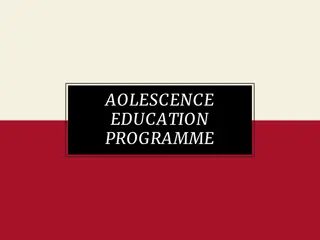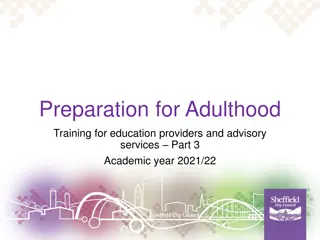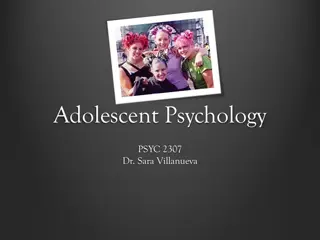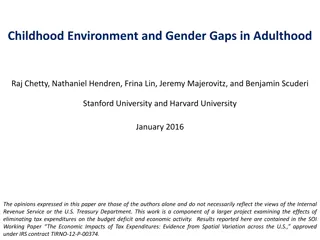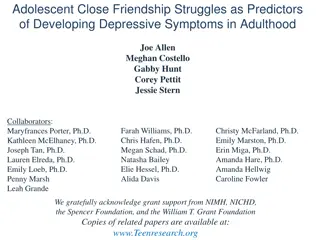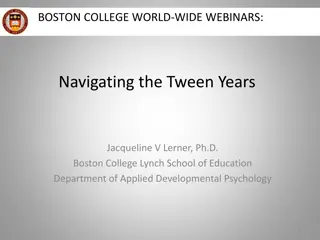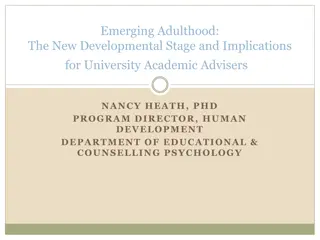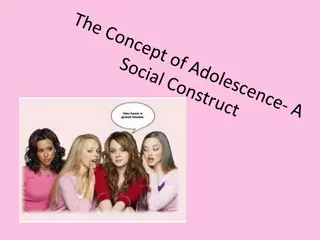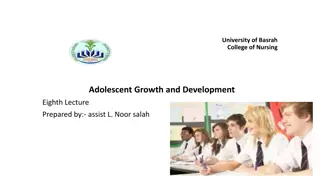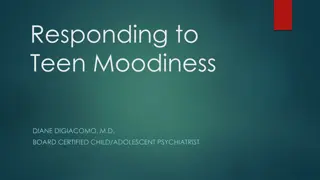Understanding Life Changes from Adolescence to Adulthood
Explore the journey from adolescence to adulthood, covering physical, mental, emotional, and social changes. Learn about puberty, emotional growth, social dynamics, adulthood stages, marriage commitments, and more.
Download Presentation

Please find below an Image/Link to download the presentation.
The content on the website is provided AS IS for your information and personal use only. It may not be sold, licensed, or shared on other websites without obtaining consent from the author. Download presentation by click this link. If you encounter any issues during the download, it is possible that the publisher has removed the file from their server.
E N D
Presentation Transcript
The Life Cycle Continues Chapter 18
Lesson 1 Changes During Adolescence Puberty: A Time of Changes Adolescence begins with the start of puberty. Usually begins between the ages of 12-18. Testosterone causes changes in male teens. Estrogen/progesterone causes changes in female teens. What physical changes occur during adolescence? Primary sex characteristics the ability to produce gametes (reproductive cells). Male gametes are sperm.
Female gametes are eggs. Secondary sex characteristics. Go through puberty at your own pace. What mental and emotional changes can occur? Cerebrum continues to develop during teen years. During adolescence you will learn to so the following: Anticipate the consequences of an action. Think logically. Understand different points of view. Emotional Changes: Search for meaning/personal values/sense of self.
What social changes occur during adolescence? Need to make friends/be accepted is important. Begin to appreciate cultural diversity. Accomplishments during Adolescence You will establish emotional and psychological independence. You will adopt a personal value system. You will create vocational goals. You will have control over your behaviors.
Lesson 1 Assessment Questions 1. Define the term adolescence and puberty. 2. What are the reproductive cells of females called? What are those of males called? 3. What are some secondary sex characteristics of males that develop during puberty?
Lesson 2 Adulthood, Marriage, and Parenthood Maturing Physically and Emotionally Physical maturity - state in which the body/organs are fully grown. Does not make you an adult. Emotional maturity - state at which the mental and emotional capabilities are fully developed. Emotionally healthy people: Give/receive love. Face reality and deal with it. Learn from experiences.
Stages of Adulthood Young adulthood 19 to 40 years of age. Middle adulthood 40 to 65 years of age. Late adulthood 65 until death. Marriage A commitment to share your life with another person. What makes a marriage successful? Communication. Emotional maturity. Values and interests.
How can couples resolve conflict in marriage? Issues that can cause problems in a marriage: Difference in spending/saving habits. Conflicting loyalties involving family/friends. Lack of communication. Lack of intimacy. Jealousy, infidelity, or lack of attention. Decisions about having children/child care. Abusive tendencies/attitudes.
What problems can occur in teen marriages? Still struggling to set goals for the future. Do not know what they want in a marriage partner. Have more responsibilities. Financial pressure. 60% of teen marriages end in divorce. Parenthood Biological/step children. Adopted children. Foster children.
Why is it important for parents to provide guidance? Learn to take responsibility for successes and failures. Learn to develop a sense of pride in their accomplishments. Learn to solve their own problems. Why is it important for parents to instill values? Positive values will help them become happy, mature adults.
Why is it important for parents to set limits? So children will learn to make the correct decisions about behaviors when parents are not present. Why is it important to give unconditional love? Helps a child meet their basic needs. What are the difficulties associated with teen parenting? Financial difficulties. Restrictions on educational/career plans. Emotional stress. Limitations on personal/social life.
Lesson 2 Assessment Questions 1. Distinguish between physical maturity and emotional maturity. 2. How do the goals of young adulthood differ from the goals of middle adulthood? 3. Which factors determine how well a person will adjust to marriage?
Lesson 3 Health Through the Life Cycle Middle Adulthood Age 40-65. May achieve career or other life goals. See children graduate from college. May welcome a new grandchild. What are some health concerns during middle adulthood? Eyesight. Hearing. Muscles and joints.
Bones. Teeth and gums. Heart disease. Cancer. What physical transitions occur in middle adulthood? Females enter menopause (can no longer become pregnant). Continue to be active and eat a healthy diet. Strength training can increase muscle mass and preserve bone density.
What mental transitions occur in middle adulthood? May begin a new career. Return to school. Learn a new hobby. What emotional transitions occur in middle adulthood? Midlife crisis. (Did I make a positive difference in the lives of others?) What social transitions occur in middle adulthood? Faced with the death of a parent. Children grow up and leave home. Pursue new interests/make new friends.
Late Adulthood Begins after age 65. Look back without regret. Feel proud of achievements. What public health policies and programs affect older adults? Social security provides benefits to older adults and people with disabilities. Medicare health care for people over the age of 65. Prepare for retirement.
Lesson 3 Assessment Questions 1. What is empty-nest syndrome? 2. What are some examples of activities older adults can participate in to remain mentally active? 3. What sort of physical changes do females experience in middle adulthood?





